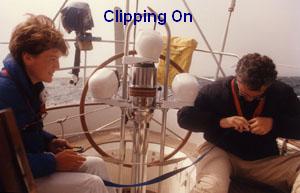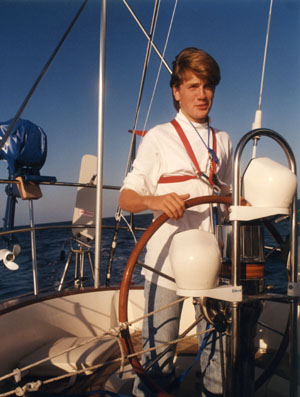Chapter 2 - Passage to San Francisco First Offshore PassageWe were generally 30-40 miles offshore, with 10-20 knot
winds from the north, About one-third of the time, when
the wind fell below 5 or 6 knots, we'd use the iron genoa, to both
continue our progress and charge the batteries. With
radar, LORAN, lights,
refrigeration, and radios, we had a heavy electrical diet
that couldn't be ignored.
Candace had the 7-11 watches, Alex the 11-3, and I the 3-7 shift. We had the whole world to ourselves, 360 degrees of water and waves. We saw the lights of a few ships the first three nights, but generally we were out of sight of land and ships the entire trip. On Candace's morning shift, August 24, she was visited by 75-100 Pacific white-sided dolphins. She saw them coming from miles away, generally in groups of three, leaping in unison. Once at the boat they continued to perform for about one-half hour, doing complete flips, belly rolls, and of course diving under the boat. One morning as I relieved Alex for the 0300 shift, we were about 20 miles offshore at the mouth of the Columbia River. We flashed the light around and saw the ocean completely covered with salmon fingerlings. Every square foot of ocean, as far as could be seen, had three or four fingerlings jumping and heading south. There must have been at least 10,000. And we didn't see the ones below the surface of the ocean. That was really spectacular. The porpoises came a few more times, the weather got gradually better, and our passage was progressing with no problems . . . except for seasickness. Candace felt really lousy the first 3-5 days, Alex didn't feel great, but never complained, and I felt punk enough to try one of those scopolamine patches. They worked pretty well, at least for Alex and me. Life under sail, 24 hours a day, is fairly difficult. The boat is always rocking and pounding through the waves, the noise of the wind and water is non stop, and it's an effort to do almost anything. Eating requires holding the plate with one hand, and a fork in the other. This means that it's impossible to cut your food with a knife, since you'd need a third hand to hold the plate from falling off the table. Of course your beverage is held between your knees. Walking around, inside the boat, requires use of the hand rails, and a plethora of bruises is inevitable. Difficulty in sleeping goes without saying, even without the need to rise in the middle of the night to take your watch. It was also quite cold. I wore a tee shirt, long sleeve shirt, sweatshirt, a heavy wool sweater, AND a down ski parka. A wool hat, gloves and boots completed my outfit. Near southern Oregon [detailed map of OR], about 0500 on my watch, I noticed a light off to starboard, but my radar showed a boat off to port. At first I thought this was because we were heeling a little to port. I held my course and soon saw the boat off to port, which was on the radar screen, and a Coast Guard cutter off to starboard, which had lights on, but could not be picked up by my radar. Could they have had some kind of device to jam radar signals? Pretty sneaky! They probably were looking for drug smugglers. They checked me out from a mile away, as they slowly continued to the north. Dead reckoning was crude, to non-existent, without boat speed or log instruments; however we felt comfortable that the LORAN was working well. Every 2 or 3 hours we'd mark our position on the chart as we continued progress down the Washington and Oregon coasts. When we crossed 42 degrees north, the skipper cried out "welcome to California,"[detailed map of northern CA] even though we were 40 miles offshore. The boogie board was put in the companionway to blast Beach Boy music out to the cockpit, the sun was shining, with temperatures in the low forties, and the wind picking up along with our spirits.
First Storm at Sea
We then put a second reef in the main, as the seas were building, perhaps to 10 feet by now in the early afternoon. Then the Yankee came down and the storm staysail was raised, as sail shortening still seemed smart. Even though the seas had grown to 12-14 feet, the apparent wind speed was only in the high twenties. We were moving quite fast, perhaps 7-8 knots down the waves, with the wind about 140 degrees off the starboard side. It was getting colder and darker as night approached, and I was becoming more and more concerned about the height of the seas and our increasing speed. We then decided to trail some warps off the stern. One 200 foot line (3/4 inch) was looped around another 200 foot line which was fastened to each to the stern cleats. This slowed us down and made steering much easier. Sometime earlier we had gone to shorter shifts, and hand steering, as I didn't trust the Monitor windvane to avoid broaching when we came down some of the big seas. It's quite a sight to see these large waves coming at your stern, way above your head, with the warps coming completely out of the water by about 4 feet, when you're in the trough. About 2000 the wind picked up even more, gusting to 33 knots apparent [about 44 MPH true wind speed, when considering the forward speed of the boat]. A third reef was "tucked" in the main, but our progress wasn't slowed appreciably. Steering was difficult, and the entire crew was quite tired. We were about 40 miles offshore, northwest of Cape Mendocino. I was concerned about our high rate of speed going down the waves, and worried about broaching. What to do? At 2200 we tried to hove to. I'd done this many times before with great success on 23 Skiddoo, my former San Juan 23, but had never been satisfied with my results on Baba BarAnn. I put the helm over, backwinding the staysail, and let the boat sail herself. Then I went below, locking the companion way boards in the hatch. We were heading straight west, away from land and trouble, but we were beam reaching at break neck speed, rather than really hoving to. This process was quite unnerving to the entire crew. The LORAN gave our progress at 9-10 knots as we screamed over the water, flying over the wave tops. The noise and motion were very unsettling. Sleep was impossible, except for Alex. By 0330 the next morning we were 90 miles offshore, the wind and seas had subsided somewhat, and we were ready for new tactics. Back to the east we headed, although our progress was much slower. There must have been some current pushing us westerly, along with the weather. We headed toward shore. Perhaps Eureka, the nearest port, would be a good spot to lick our wounds and regroup. As we neared the coast and came within VHF range, we called the Coast Guard to find out the tidal situation at our midnight ETA. Unfortunately, the tide was going to be ebbing, maximum current, going into the teeth of the seas. Rather than wait around for a more prudent time to cross over the bar at Eureka, we decided to continue south. This was not the time to have another major problem with the roller furling. Somehow a cotter pin in the staysail stay turnbuckle had worked itself loose. While rolling up the staysail, the stay came completely out of the lower turnbuckle. Now we had the staysail stay, with the staysail partially wound around it, flaying all over the deck, lashing out at the mast, the radar dome, us, the shrouds, you name it. While thrashing around, it cut the bottom line to my Firdell blipper radar reflector. Even though it remained attached at the top, the radar reflector banged against the mast for the rest of the trip. Using the sheets, we got the stay wound around the mast a few times and under control. At least it wouldn't decapitate anyone. The staysail was then unwound, and unhanked, somehow, from the stay. Then the stay was reattached to the turnbuckle, and of course a cotter pin was firmly inserted. God, that was almost a real disaster! Progress under sail, and sometimes under motor, was pretty good as we closed in on San Francisco. Our ETA in SF was 0400 on Wednesday, August 30. To avoid arrival at that hour, we decided to spend the night at Bodega Bay, about 55 miles north of SF. We had a glorious beat to the east, winds in the 20-25 range, and fairly high seas. The fog was quite thick in the morning. As we neared the coast and shipping lanes, our radar was called on more and more to avoid collisions. Alex saw land first, after a week at sea. Coming into Bodega Bay the winds increased to 28 knots. Neither the staysail, nor the Yankee could be rolled up completely with our rotten roller furling. In that wind, it was necessary to unroll the Yankee, and then unhank it from the forestay. As Alex and Candace struggled with the Yankee, the staysail came unwound further with the leech of the sail thrashing mightily. Damage to the leech was such that Candace had to spend an afternoon fixing it once we got to SF. With sheets and sails thrashing about, this was really ugly. Under motor I headed downwind to lessen the apparent wind speed, but this provided only partial relief. Just as we got the staysail under control, the Coast Guard from Bodega Bay came speeding out to see if we needed any assistance. Perhaps earlier we could have used some, but now we were OK. So into Bodega Bay for the night. Yes, it was difficult walking on land with our sea legs.
Into San FranciscoThe next day, in thick fog, we motored the remaining distance to SF. Although we could see the pillars at the base of the bridge, the Golden Gate was otherwise completely hidden from view. As we headed into Sausalito, the wind, which had been pretty much nonexistent the entire day, picked up to 28 knots. While we motored around, looking for moorage, we got stuck in the mud for about 10 minutes. Welcome to the Bay! It is really shallow everywhere. Our first offshore passage is history. We arrived safely, although somewhat battered. Our Mariner roller furling was the cause of most of our grief. Next, being unprepared for the high seas provided most of the remaining problems. We resolved to scrap the roller furling, and replace it with traditional sails that raise and lower the old fashion way, with halyards. I got a copy of Heavy Weather Sailing by K Allard Coles and started devouring it immediately. I never realized that the learning curve would be so steep! And we'd only just begun.
|

